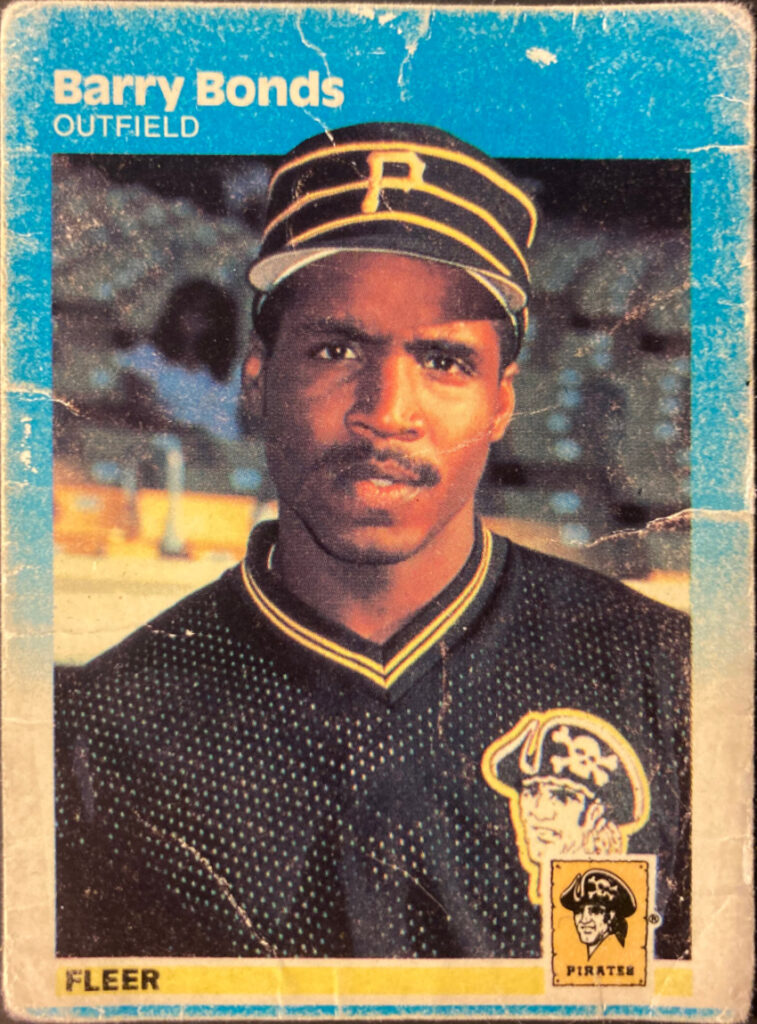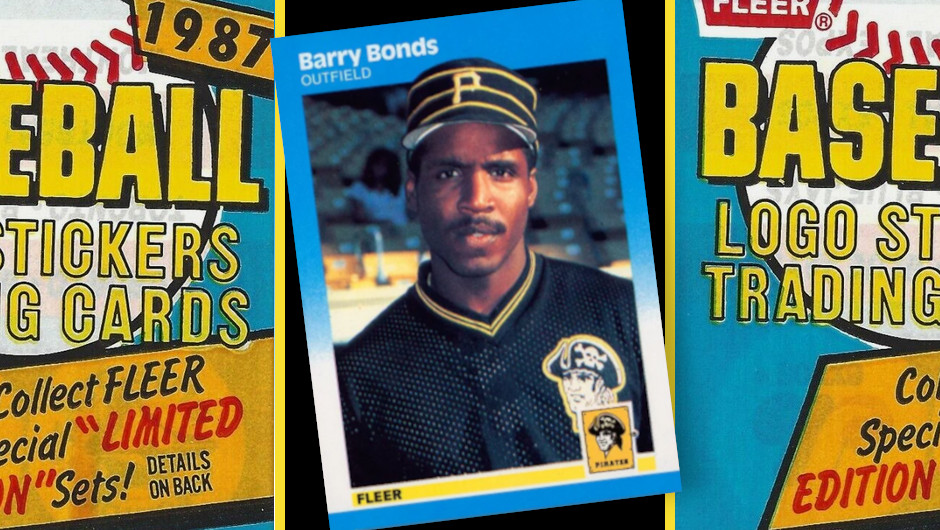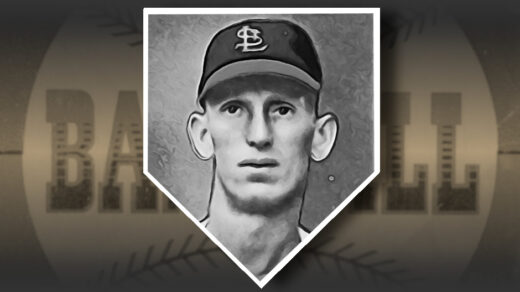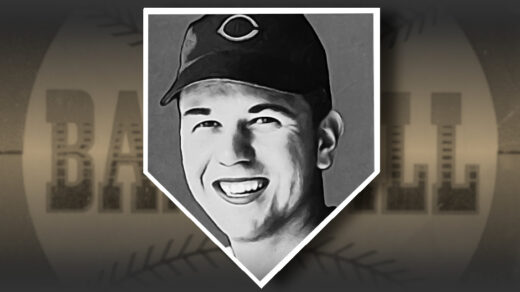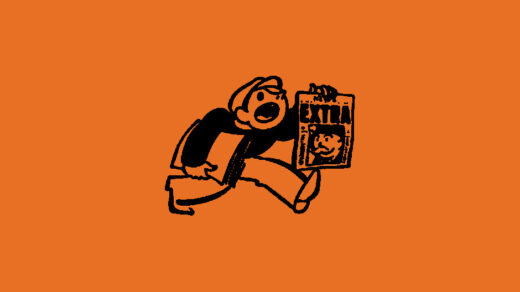I began collecting baseball cards during Christmas break in 1990. Over the next few years I built out what I thought was the best collection a kid with a $5 weekly allowance and a growing roster of lawn care clients could create. Budget constraints forced choices to be made, and as a result I acquired a lot of second tier cards. Instead of a pricey Topps Cal Ripken rookie, there was one from the less popular Donruss issue. When it came time to reach back to the rookie-heavy 1987 sets, it was the very plentiful wood grain Topps cards that entered my collection, not the less often seen bright blue borders of ’87 Fleer.
The rookie crop that arose from 1987’s offerings was amazing and defined the era in which I was most in love with the sport. Sure, the cards were junk wax but 1987 has sort of gained the reputation of being the “good” part of the junk wax era. With that backdrop in mind, the home run chases of the late 1990s and Barry Bonds’ record season prompted my best friend and I to go half and half on a box of 1987 rack packs in 2001. The set we targeted was Fleer, one that we had avoided due to cost constraints a decade earlier. We opened every pack in one sitting, a time consuming activity considering that Fleer created its rack packs by simply encasing a trio of sealed wax packs in an additional layer of cellophane. The result: A handful of off-center Bobby Bonilla cards but no Barry Bonds.
Fast forward a couple decades. I returned to collecting baseball cards and needed some way to limit how expansive the collection might become. A chance encounter with another collector’s blog revealed a “wallet card,” a baseball card of a favorite player that was essentially destroyed by keeping it unprotected in his wallet for an entire year. The otherwise unremarkable card was fascinating, transporting normally Near Mint junk wax cardboard into something resembling the low grade vintage cards from the 1950s that I drooled over in my first collecting period. This was it. When adding cards outside of my primary collecting interests I would do so by making them into wallet cards.
The first such cards were deployed on my birthday a few years ago and I have been changing a trio of them out every February since. My 2022 selection included the 1987 Fleer Barry Bonds rookie that had eluded me for so long. With it sitting in my wallet for a year, and I in turn sitting on it, there was plenty of time to learn everything I could about the card. Here’s what I discovered.
A Closer Look at the Card
Take a look at the photo of Bonds on this card. Many of his earlier photographs show him smiling, happy to be progressing through the minor leagues and on his way to the Pittsburgh Pirates. This image, however, doesn’t show him smiling or even holding a genial but serious pose. There’s a trace of a smile, but it is quickly being dropped in favor of a look of exasperation. He looks like he is being detained one moment too long to capture a final shot. One anecdote from this period, possibly apocryphal, involves Bonds responding to a baseball card photographer’s request for a pose by retorting “Can’t you just use last year’s photo?” You can look back at earlier photos and wonder what changed. With this card, you can look back and immediately recognize Bonds. He’s found himself in this photo.
While the card does not provide photo credits, I am 99.9% certain that it was taken by Fleer staff photographer Lou Sauritch. Sauritch was one of several photographers who took a regional approach to capturing the images that filled baseball cards for the company. Bob Bartosz and Steve Babineau split American and National League duties on the East Coast while California-based Sauritch handled the West Coast work.
The background features yellow first level stadium seating just above what appears to be a dugout roof. The ballpark in Pittsburgh did not have such a color scheme and neither almost every other National League team. Dodger Stadium, however, was in Sauritch’s backyard and features outdoor seating that perfectly matches the backdrop.
Bonds is shown in a road practice jersey with the distinctive pillbox cap last used in 1986, his rookie season. Given Pittsburgh’s travel schedule and 44 minor league games he played in Hawaii at the start of 1986, the picture must have been taken during a period covering four games that season. Pittsburgh played Los Angeles each day from July 3-6. Bonds went 3 for 19 in this series with a homer and 3 RBIs.
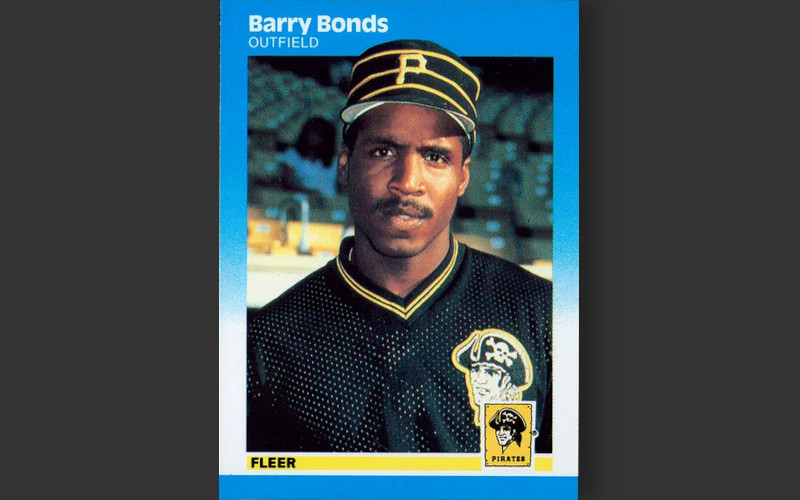
Upon turning the card over viewers are greeted with a red white and blue color scheme. The red highlighted columns are not chosen randomly. They represent the statistics necessary to tally batting average, home runs, and runs batted in, the three stats that make up the sport’s Triple Crown.
The largest text is reserved for the card number and player name, both of which appear at the top of the card. Fleer followed a unique numbering system with its cards. Teams appeared in the set checklist in the order in which they finished the prior year, resulting in the World Series winning Mets taking up spots 1-25, the runner up Boston Red Sox as numbers 26-48, and so on. The Pittsburgh Pirates were terrible in 1986, placing the team last in the set’s numbering system. Within teams, players appeared in alphabetical order. Bonds appears as card #604, right next to Bobby Bonilla, with whom he would be so connected with for the next five seasons.
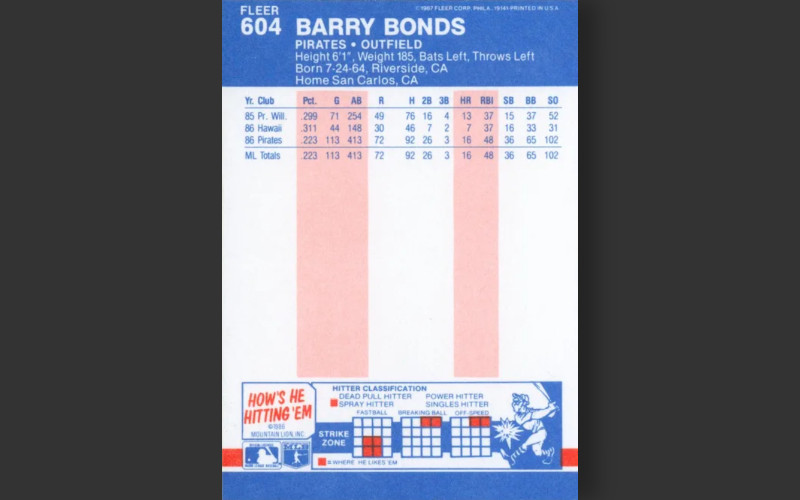
The cards offer nothing but statistical information, though Fleer leaned into the stats with a graphic at the bottom displaying more nuanced interpretations into just how those stats had been accumulated. For position players like Bonds this included a 4×4 grid to represent the strike zone with specific segments highlighted to show which pitch locations he was most effective against. The exercise starts out with an analysis of performance against fastballs and is repeated for breaking balls and off-speed pitches. This is notable, as it was Fleer’s first attempt at any analysis beyond the tabular presentation of traditional baseball stats. It may even be the first time this kind of information was ever put to cardboard.
I sorted through hundreds of ’87 Fleer cards and found one batter with an identical profile to Bonds. Like Bonds, Phillies catcher Darren Daulton is shown as preferring low fastballs offset by high and inside offspeed offerings.
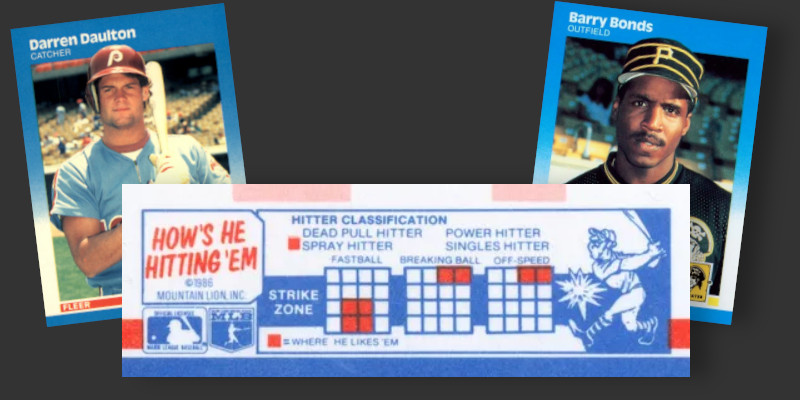
Hobby Reaction
Fleer entered 1987 after three years of producing “good” sets in the eyes of collectors. Beginning in 1984 its cards were seen as potentially more attractive than Topps, though cards issued by Donruss were enjoying an even greater rise in hobby esteem. That changed with the 1987 Fleer release.
Early 1987 price guides debuted with Donruss and Fleer sets at almost identical values. By the end of the season the Fleer set was routinely selling for a 10% premium over Donruss and was receiving regular votes from readers for Beckett‘s Hot List. Though beset by ups and downs of overall hobby demand, ’87 Fleer has never really relinquished its place as that year’s most popular major release.
However, the Bonds card was far from being the most sought after rookie in the early days of the set. At the end of the year collectors were more interested in Kevin Seitzer (5x Bonds), Bo Jackson (4.5x), and Ruben Sierra (2.5x). Bonds was not the key card in the set even after winning his first MVP award in 1990. At that time collector demand for Will Clark’s Fleer rookie was triple that of his. The same ratio remained in place after Bonds finished 2nd in MVP votes the following year. Five years after the card’s release and after an additional MVP award, the Bonds card was still considered to be half the card of the Will Clark rookie and held roughly on par with the set’s Ruben Sierra rookie card.
It would not be until the end of the 1993 season (and Bonds’ third MVP inside of four years) that collectors would begin to consider the card to be the key to the ’87 Fleer set. Stasis set in around this point. The overall set was firmly entrenched as the preferred representation of the ’87 season and the Bonds card was the key component of the checklist. Popularity of the sport, however, was about to get mauled by the effects of the 1994-95 strike and the ready availability of late-’80s junk wax cards meant there was no shortage of the cards for remaining collectors to find.
That changed when Bonds hit 73 home runs in 2001. By the end of the year collectors were once again seeking out his rookie cards. Attitudes towards what constituted a rookie card had changed in the eyes of the hobby, resulting in Bonds’ 1986 Topps Traded issue taking over as the ideal card of the Giants’ giant slugger. The Topps Traded card took the top spot in the year-end Beckett Hot List, though it should be noted that the ’87 Fleer finished the year as the fifth most popular card in the hobby, slotting in between one that year’s pack-pulled Ichiro Suzuki autographed rookie cards and Bonds’ 1986 Fleer Update card.
The ensuing two decades have seen Bonds’ reputation take a nosedive, often relegating this once popular card to bargain bins. Still, demand for the upper echelons of condition and rising popularity of third party grading has led to some eye popping numbers for top-grade cards. Multiple reports of $1,200+ transactions were reported in 2002 for examples graded BGS 9.5. The December 2000 Beckett even reports a going rate of $1,500 to $2,500 for Gem Mint slabbed cards. The record for the glossy version was set in 2021 when a gem mint card with a special provenance sold for $3,690 via Goldin Auctions.
Printing and Distribution
Fleer printed its 1987 release on five different sheets of 132 cards. The layout was arranged so that teams, and by extension consecutively numbered cards, are grouped vertically on the sheet. Bonds Appears near the bottom of the fourth sheet in the second column and next to last row. Neighboring cards include Jose Guzman of the Texas Rangers on the left and Scott McGregor of the Orioles on the right. Bonds’ teammates Don Robinson and Joe Orsulak above and below. These sheets and team-themed vertical strips remain fairly easy to find.
The cards were sold in a variety of packaging, ranging from traditional wax packs to various cellophane wrapped assortments. Complete sets, each containing the Bonds rookie, were sold in multiple configurations based on the kind of outlet through which they would be sold. Fleer increased the number of cards in its wax packs for 1987, including 17 cards instead of 15 in an effort to appeal to value-conscious collectors. Topps followed suit with a similar increase in wax pack contents for 1987 while rival Donruss maintained its traditional 15-card arrangement. Mixed among the regular blue-bordered ’87 Fleer cards coming out of packs were a pair of heavily produced insert sets.
| Distribution Method | # Cards Included | % Chance of Finding at Least 1 Bonds |
|---|---|---|
| Factory Set (Hobby) | 672 | 100.0% |
| Factory Set (Retail) | 660 | 100.0% |
| Rack Box Floor Display (Red) | 8,640 | 98.7% |
| Rack Box (Blue) | 1,224 | 84.5% |
| Cello Box | 744 | 68.9% |
| Wax Box | 612 | 61.0% |
| Rack Pack (Blue Wrapper) | 51 | 7.5% |
| Rack Pack (Red Wrapper) | 45 | 6.6% |
| Cello Pack (sight unseen) | 31 | 4.8% |
| Cello Pack (no Bonds showing) | 31 | 4.4% |
| Wax Pack | 17 | 2.6% |
How Many Bonds Rookies Were Produced?
I wish I had a precise answer to this question, but I have not yet found a satisfactory method for calculating the print run of this specific set. I have financial records of some later years of Fleer and competitors and might be able to back into an estimate from that. However, this will be time consuming and a project for another day. If I come up with a plausible number I will be sure to update this section with the results.
In the interim, the short answer is that there is likely a literal ton (or more) of ’87 Fleer Bonds cards in existence (907,185 1-gram cards per ton for those wondering). The four major third party grading companies have expressed opinions on more than 44,000 examples. It is the 22nd most-graded baseball card in PSA’s history and 8th on the all-time leaderboard at Beckett. Fleer’s production had been ramping up for several years at this point and would continue to do so for another 4-5 years. My guess is there are somewhere between 1 and 1.5 million of this card floating around in collections with the actual number likely somewhere towards the lower bound of this range.
Similar Cards
Good cards show up again and again. Topps will almost certainly produce another modern printing of the ’52 Mickey Mantle for collectors to seek in packs. Aside from the 1989 Fleer Billy Ripken error card, the ’87 Barry Bonds is probably Fleer’s most well known piece of cardboard. It’s the most fun you can have with a Fleer card without reading an obscenity.
Fleer actually produced two different Bonds rookies in 1987. The majority of Fleer cards were issued in packs while a special edition of each card was produced and sold as a complete set exclusively in authorized hobby outlets. Known in hobby circles as the Fleer “Glossy” set, the cards carry much more gloss than their pack-pulled counterparts and were packaged in a commemorative tin. While glossy fronts and metal packaging constitute all the differences between the two versions they are considered to be separate cards. Glossy versions are less common than traditional ’87 Fleer cards but are not considered rare. Widely reported estimates put production figures north of 75,000 sets and potentially into the low six digits. Production figures will be a multiple of 15 given the case size of 15 sets in which these were sold to hobby dealers.
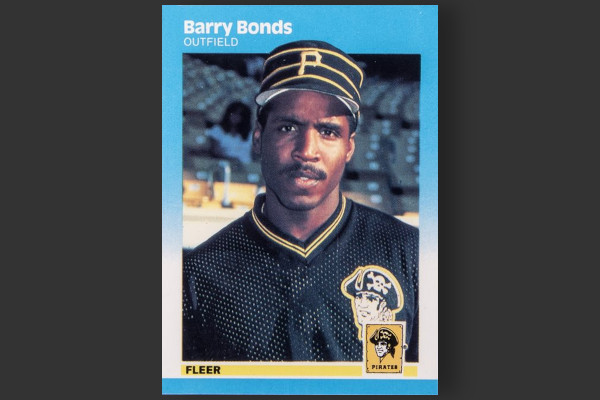
Ten years later Fleer brought back the ’87 Bonds card for the first time. Packs of ’97 Fleer Series 2 included random inserts of a 12-card set titled “Decade of Excellence.” Fleer had been producing modern cards since 1981, though they understandably decided to downplay their pre-1987 offerings. These cards were found at a rate of one per every other 18-count wax box. Each name in the set uses the familiar blue/white gradient on the border and features a player who was present in the original 1987 checklist. These cards utilize different photos than the originals and match the team logo and color stripe at the bottom with the athletes’ 1997 team affiliation rather than their original ’87 clubs.
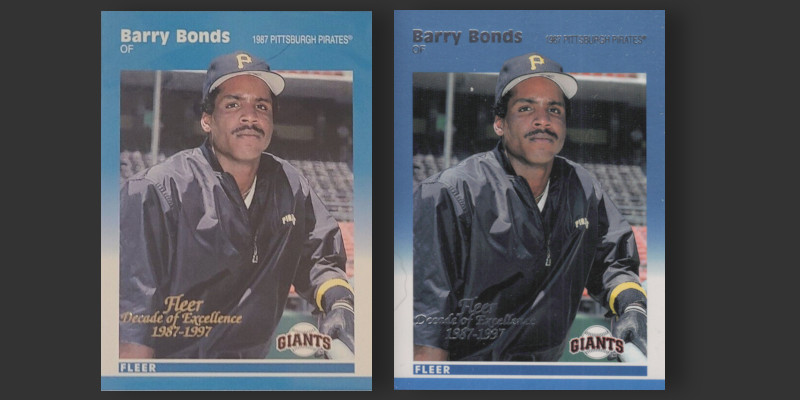
As a product of the late ’90s, the Decade of Excellence inserts were also produced in a parallel version. Fleer produced “Rare Traditions” variations of the card with one-tenth the production levels of the regular insert, essentially making each card a case hit. These cards can be distinguished from the more plentiful version by silver foil lettering at the top of the card and the title Rare Traditions in stylized script at the base of Bonds statistics on the reverse.
Fleer really likes anniversaries. Four years after the last Bonds insert the card producer released a 20-year retrospective set titled Fleer Platinum 20th Anniversary in honor of its debut 1981 set. Bonds’ 1987 rookie again makes an appearance, this time as an easy to find insert with minimal deviations from the original design. Only a small Fleer logo and a red and white box identify the front of the card as hailing from 2001. A small line of text above the “How’s He Hittin ‘Em” box on the back discretely reiterates the card’s reprint status.
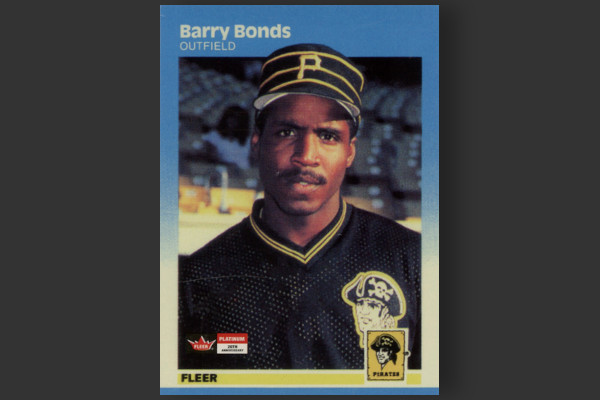
The next year Fleer somehow had another platinum anniversary and again referenced the 1987 set. Given Bonds’ record-setting 2001 season, Fleer chose to issue its entire 2002 Platinum edition using the same design as the blue and white ’87 cards. The solid line of color linked to each team is changed for several clubs in the 2002 issue, moving from blue to orange for Bonds’ San Francisco Giants. Fleer’s logo once again appears inside the borders of the card photograph and is larger than the previous year.
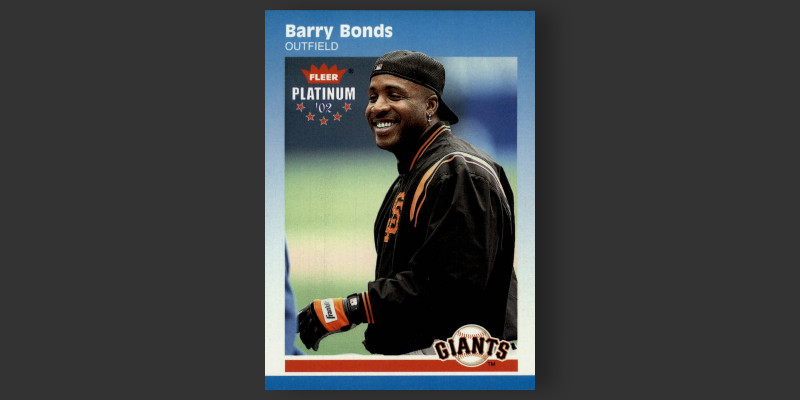
Fleer didn’t make it to its next anniversary, collapsing into bankruptcy in 2005. However, Upper Deck released a Fleer card for its own 30th anniversary in 2019. The company purchased Fleer’s intellectual property in the post-filing liquidation, giving it the rights to the 1987 Fleer design. Of course, intellectual property can be a strange thing. Upper Deck subsequently lost its license to produce Major League Baseball cards and hasn’t produced baseball cards in over a decade. Since then they have focused on hockey and non-sport cards, particularly the comic book offerings that Fleer and Marvel had cultivated since the early 1990s.
Following the 2018 release of Deadpool 2, Upper Deck produced a set of trading cards celebrating the comic book character. Randomly appearing in packs were “Sportball!” inserts that parodied iconic baseball cards produced by Upper Deck and Fleer. The 1987 Barry Bonds card appears front and center in the set in the form of a mustachioed Deadpool posing in a pillbox hat against the familiar blue and white borders.
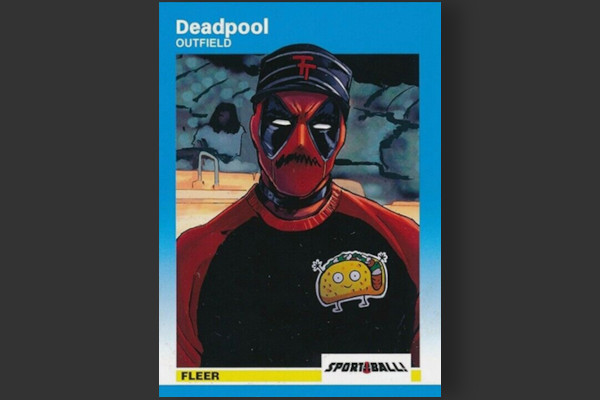
Trade Night Possibilities
Baseball card shows have existed for my entire life, a period now creeping into its fourth decade. While much of what they offer remains little changed, there has been a noticeable increase in the number of multi-day shows setting aside time and facilities for attendees to make trades amongst themselves rather than keeping their interactions confined to the show’s vendors. I haven’t actually made it to any official trade nights, but would have definitely loved it as a kid.
As explained in an earlier in depth wallet card profile, there was a strictly enforced rule regarding trades conducted between my friends and I. Any cards swapped for each other had to have an equal value in the most recent Beckett price guide. The guide offered two prices (i.e. LO and HI values) and we could reference them in any way that made the numbers work, so long as both parties used the same method. We could both look to the low value column, the high value, or average the two together. The latter worked particularly well when the market for a desired card was very much in flux and the spread between high and low prices was abnormally wide.
Shown below are a series of trades at different points in time that would have easily passed our price guide-based fairness test. Every example shows the average LO/HI value at the end of the year for the ’87 Fleer Bonds rookie, along with two additional cards carrying the exact same valuation. Someone holding a Bonds card could look to the left or right and swap their card for one of the others being offered. These potential trades offer a fantastic timeline of the rise and fall of this card’s popularity.
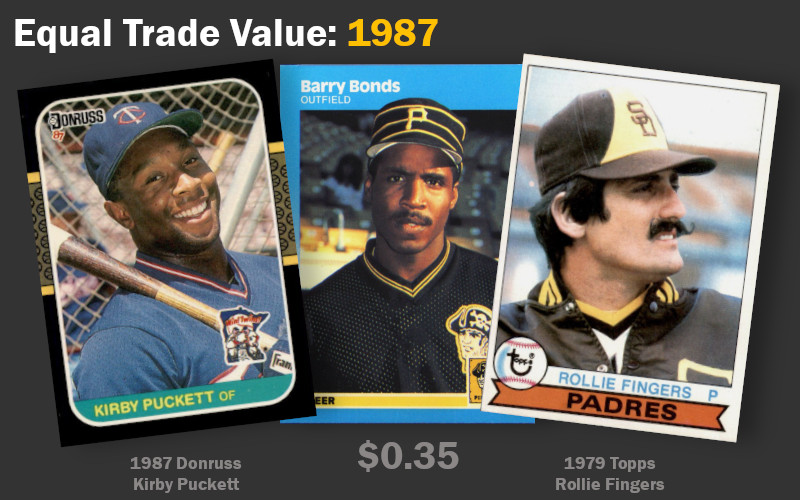
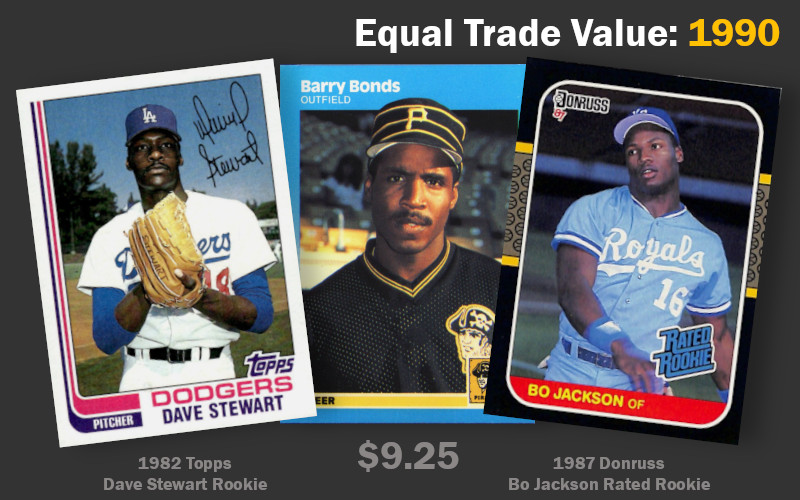
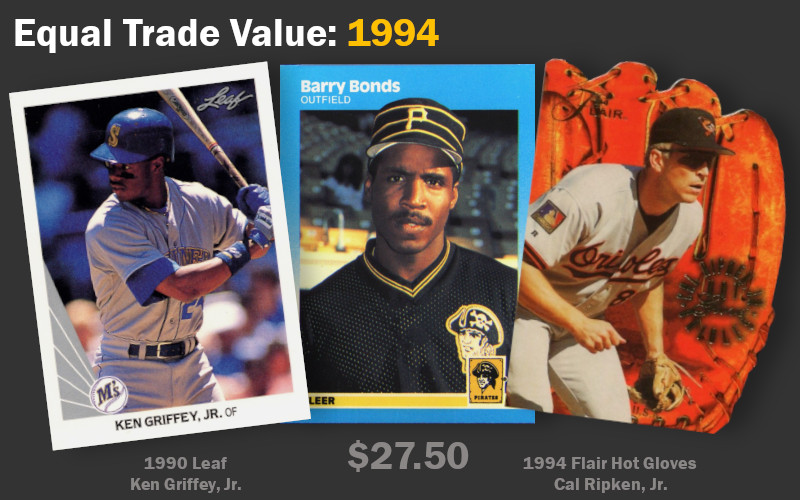
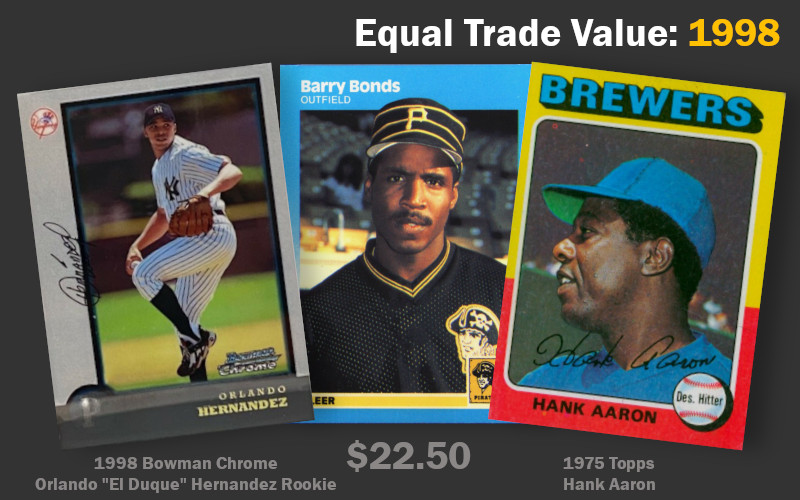
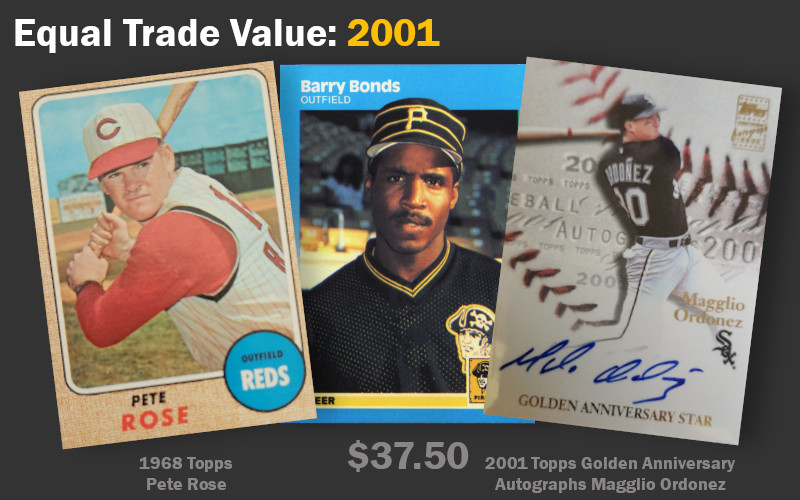
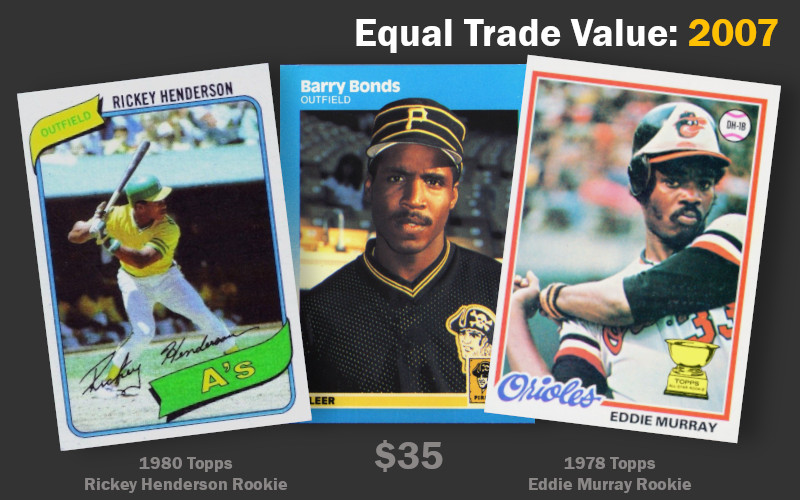
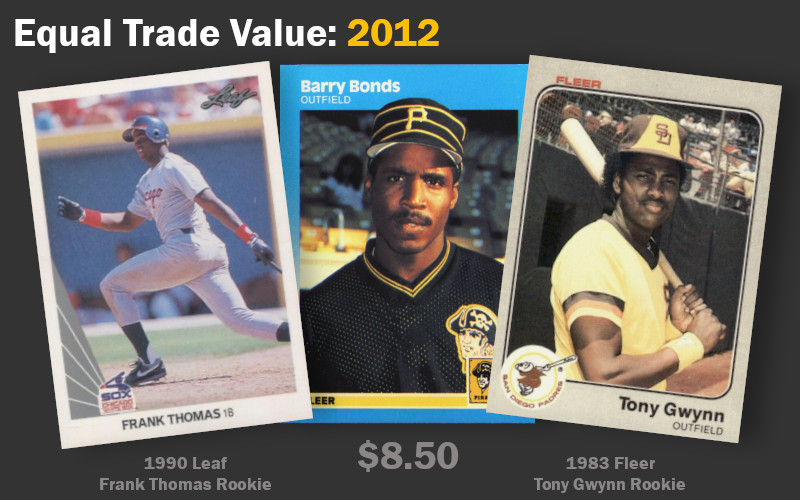
Of course, widespread use of the Internet and searchable online marketplaces have knocked Beckett from its perch as the ultimate authority on card values. Looking at eBay and COMC’s recent offerings, I found a couple cards with identical pricing that would garner serious consideration from collectors looking to make a trade.
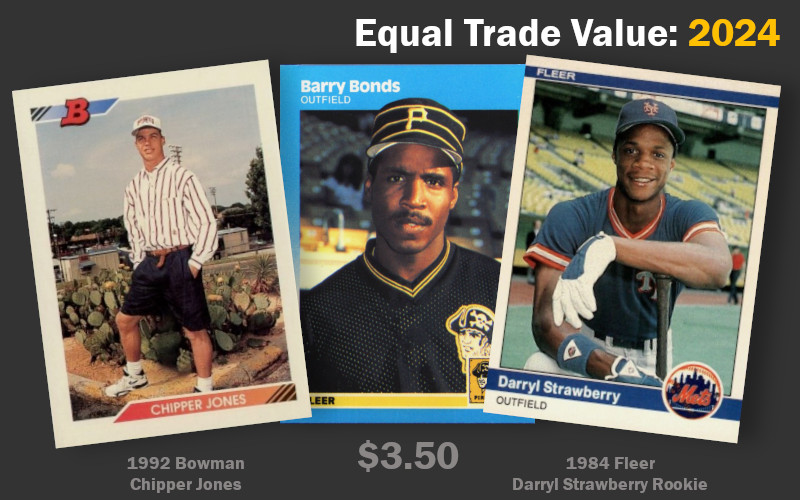
My Card One Year Later…
